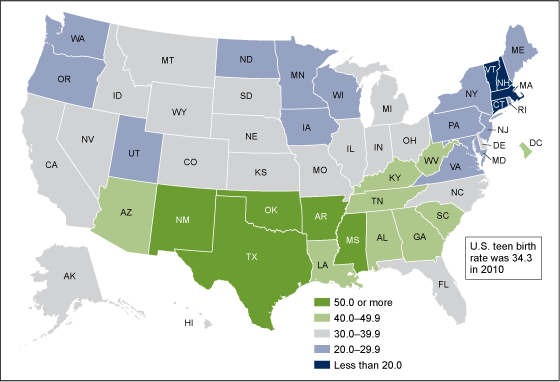The good news is that it’s declining. The bad news is that as with so many other things, Texas ranks among the lowest in the country.
Despite a slight improvement from 2009, Texas still had one of the nation’s highest teen birth rates in 2010, data released Tuesday show.
Texas took a baby step in the newest report, moving from having the nation’s third highest birth rate for teens between the ages of 15 and 19 in 2009 to the fourth highest in 2010, according to the U.S. Centers for Disease Control and Prevention.
Teen birth rates have been falling nationally and are now at an historic low going back to 1946, according to the CDC.
Texas has made dramatic strides in two decades, when its birth rates for teens 15 to 19 fell from 78.4 per 1,000 in 1991 to 52.2 in 2010, according to the CDC data. That’s a drop of 33 percent. But teen birth rates for the nation as a whole have been falling faster, from 61.8 per 1,000 in 1991 to 34.3 per 1,000 in 2010, a 44 percent decline.
“This is good news, but it’s not as good as it could be,” said David Wiley, a health education professor at Texas State University and founder of the Texas Campaign to Prevent Teen Pregnancy. “This isn’t anything to throw a party over.”
Chris Van Deusen, a spokesman for the Texas Department of State Health Services, said teen birth rates and teen pregnancies in the state “have been on a fairly steady decline.”
He provided data on teen pregnancies for girls ages 13-17 and said the state does not have quick access to the birth data used by the CDC.
“While the teen pregnancy rate has been declining, there is still room for improvement,” Van Deusen wrote in an email, “and we’re going to continue working toward that.”
You can see the CDC report here. I’m not sure what specifically Mr. Van Deusen has in mind for that, but it probably doesn’t matter. Via Sarah Kliff, who has some charts to illustrate the CDC’s data, we get the following:
In a new working paper, Kearney and Levine looked at international differences in birth rates, as well as variations among American states. There are widespread differences in rates: New Hampshire’s stands at 16.4 births per 1,000 teens, while Mississippi’s is 64.4. The researchers found a state’s level of economic inequality to be a significant influence in the birth rates. All other things being equal, “teens in the highest-inequality states are roughly 5 percentage points more likely to give birth as teens in the lowest-inequality states,” Kearney and Levine wrote. This was true even when the researchers controlled for the individual teenager’s economic status.
“We conclude that women with low socioeconomic status have more teen, nonmarital births when they live in higher-inequality locations, all else equal,” they said. “Our estimates suggest that income inequality can explain a sizable share of the geographic variation observed in the teen childbearing rate, on the order of 10 to 50 percent…To the extent that greater levels of inequality are associated with a heightened sense of economic despair and marginalization, our empirical findings support this claim.”
That economic inequality can produce high teen birth rates would align with what we know about disparities in wealth here and abroad. The World Bank has consistently found a greater level of economic inequality in the United States than in Europe.
Some other factors may also be behind the discrepancy. American teens tend to have intercourse at lower rates than some of their international counterparts, yet they are also less likely to use contraceptives. About one-third of American teens terminate their pregnancies, which is an abortion rate similar to that of Germany (31.3 percent) but slightly lower than other countries, such as the United Kingdom (38.8 percent).
I predict with great confidence that the state of Texas will do nothing to address this. Indeed, the budget cuts of 2011 did about as much as humanly possible to exacerbate it, in the short term as well as in the long term. If and when the subject of teen pregnancy comes up in the next legislative session, I predict this won’t even be part of the conversation. So don’t be surprised when not much has changed when the next batch of data gets released.


Of course the State won’t do anything. That’s because the idiots in charge think the only real solution is to tell the teens to not have sex until they get married.
Pingback: Another reason why Texas has a high teen pregnancy rate – Off the Kuff